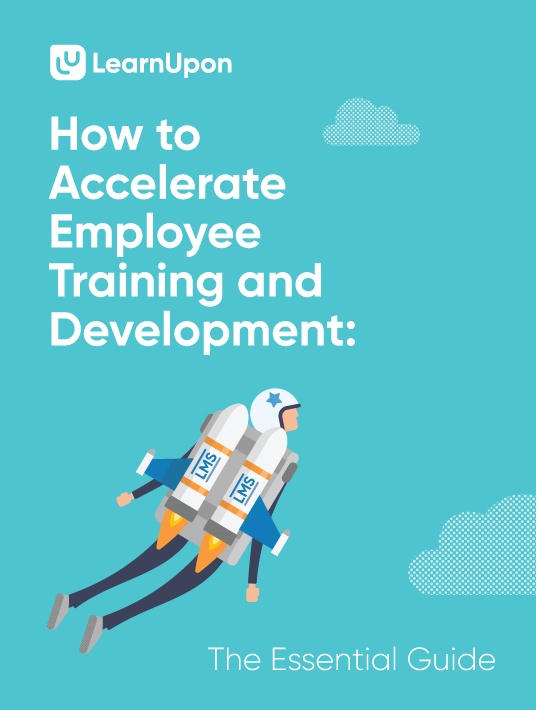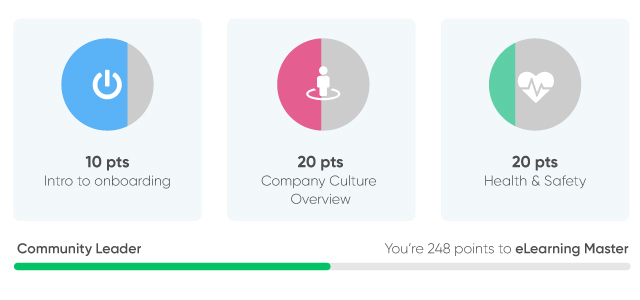Increase Engagement With Your Employee Training Software
eLearning engagement is a willingness for your learner to interact consistently with the training provided in order to achieve a learning goal. It’s a fundamental part of eLearning and contributes directly to its success. High user engagement is often seen as being difficult to achieve, and businesses struggle with it. In a 2017 study that we conducted at LearnUpon, 71% of the businesses we polled found engagement to be the most challenging part of delivering training. That’s a high number. So, what do you do to beat this challenge? Importantly, you need to find an LMS that has the features needed to effectively engage each employee. It should help you make learning fun but also do much more: it needs to make learning accessible, simple, and inviting so that there are no barriers to your learners’ success.

Notifications
A notification will likely be your learner's first interaction with your LMS and their training. Notifications will also make your learner aware of the courses they are enrolled in, due dates, and more. They’re key to getting your learners engaged with training. Therefore, it's essential that your LMS enables you to send triggered notifications via email or in-app to make your learners aware of what’s happening. A good LMS should have automated notifications so that you can ensure learning is top of mind. They should be customizable so you can personalize them for users, and they should automatically send when needed - once a learner has been added to your LMS, when they are enrolled in a course, etc. Also, the ability to send automated reminder notifications is important. If a user is enrolled in a course that has a due date looming, your LMS needs to allow you to set automated reminders to point out that they've training to complete.
A Learner-Friendly Interface
The last thing you want or need is an LMS that is complicated to use. It's a big turn off for users. They want to easily log in, access their training without any barriers or confusion and when this doesn't happen, they’re likely to become frustrated, log out, and not want to engage with training again. An LMS that is purposely designed and built to be user- friendly is key. One that provides effortlessly accessible training, where your learners can clearly find the courses they need to take, and where a single click takes them right to their starting point without any friction. This will lead to fewer bumps in the road when it comes to training for your learner and in turn, increase engagement.
Mobile-Friendly Learning
Your employees are busy. It’s difficult for many of them to find time to complete their training. So it’s essential you focus on one major element that influences engagement - accessibility. Accessibility to courses should give learners every opportunity to learn when and where they want to. A mobile-friendly LMS makes learning on-the-go incredibly easy. Whether they’re at their desk, on the bus commuting into work, or taking a coffee break, your employees can complete their courses on the device they choose.
Learning Paths
Learning paths are a great way to save you time. They are also an incredibly useful way to encourage your learners to keep coming back to their training. It's a feature that bands several courses together to create a step by step path to an overall training goal. You plan out the courses that you want to be tied together, and when a user completes one course, they’re automatically enrolled (or given the option to enroll) in the next.

It's typically used for courses that are based on the same subject or training program, like new hire onboarding. Learning paths are a method to continuously engage your learners as they’re constantly encouraging them back to your LMS to train. It also keeps your learners on track, guiding them towards an overall goal. This feature also has an added benefit for you: it enables you to enroll multiple users in multiple courses all at once, saving you valuable time.
Gamification
Let's face it, training isn't always the most exciting task for an employee. However, you can transform it into an engaging experience with gamification. It works by adding game mechanics that set goals, milestones, and achievements at different stages of the learner's training. It results in them being motivated by their progress to continue learning. Popular ways to gamify eLearning include:
- Badges: These are awarded to your learner when they finish a task, for example completing a course.
- Points: Used to mark achievement and progress, your learner is given points when they reach a certain target.
- Levels: When your learner collects enough points, they climb up different levels that you have set.
- Leaderboards: Who has the most points and who has engaged the most with course content? Leaderboards show your most active and engaged learners for all to see.

Gamification works well for employee training and development as it makes learning fun. Also, as you can allow coworkers to see how they’re performing, it adds a social element (and a little friendly competition too!).
Social Learning
Social learning via a forum in your LMS is a stellar way to add an interactive component to learning. It solves a common issue that businesses delivering online training often come up against - learner isolation. A forum available to use within your LMS creates a community for your employees to chat about the training programs on offer. Typically, everyone in the forum has a user profile that enables them to react, respond, and contribute to a topic. You can also assign a role as a moderator who can keep all discussions appropriate and on topic. What's great about discussion forums is that instructors can pose questions to learners and vice versa. You can set topics that encourage learners to engage with your training, share resources and thrash out ideas. It also motivates peer-to-peer learning and engages learners before, during the course, and beyond.
Multimedia Course Content
All of the above features impact your engagement rate, but there’s still one key component that matters the most - your course content. Creating content that’s diverse and absorbing is an essential aspect of eLearning. The best course content comes when you mix it up, and an LMS that has the features that allow you to do this is invaluable. The ability to use multiple content formats, video and audio, assessments, and even hosted live sessions in combination ensures you can create a dynamic learning experience. Collectively, all these features work to make your employee training and development much more effective. However, it’s essential you test and experiment with your LMS features to discover what your audience responds to. Download the eBook How to Accelerate Employee Training and Development to discover how you can increase engagement with your employee training software, amongst many other great tips.
For those interested in learning even more, at a more advanced level, check out the Make Your Employee Training Robust And Engaging: How To Get The Perfect Balance webinar. It is brought to you by LearnUpon and tells you everything you need to know to make your employee training robust and engaging.


